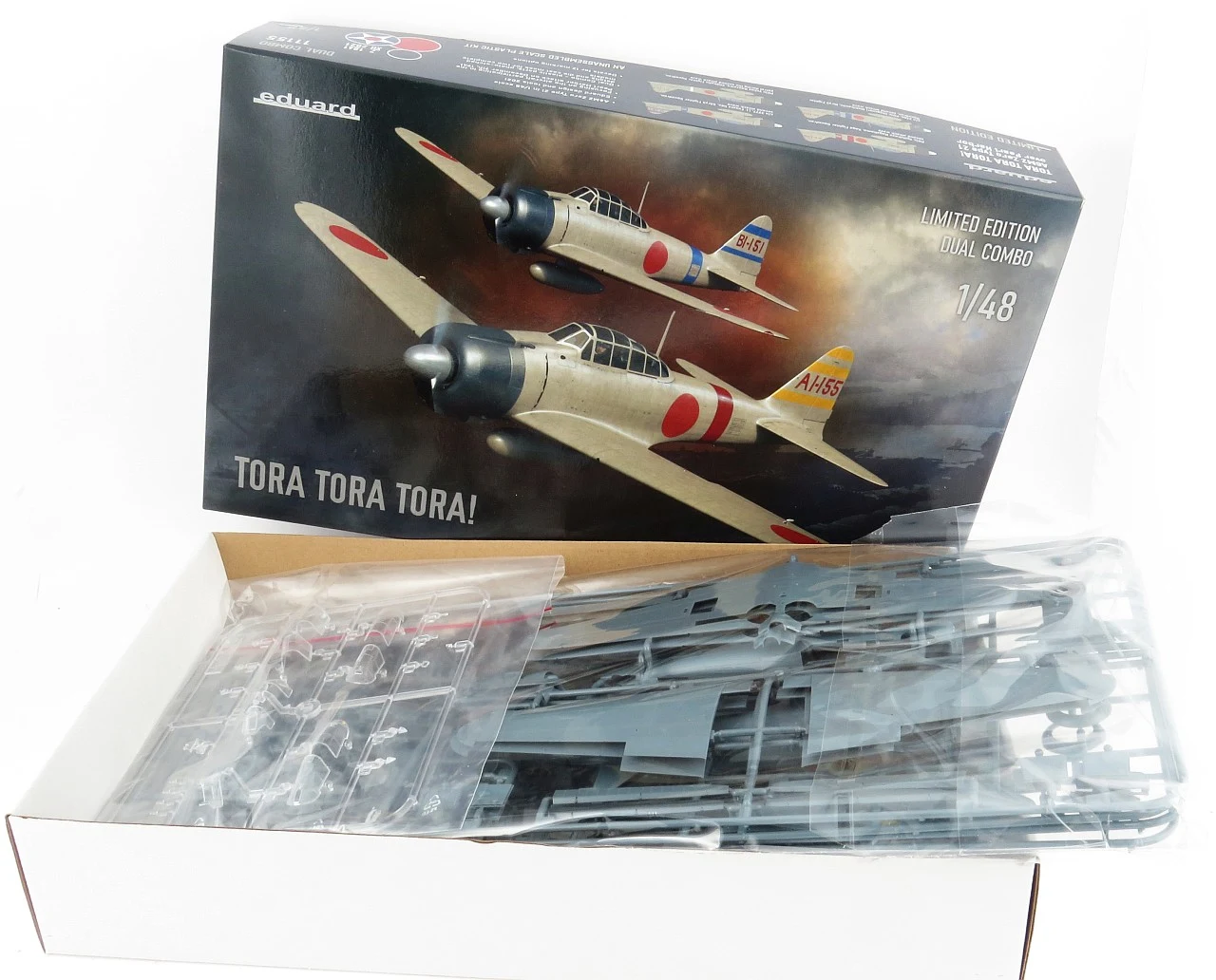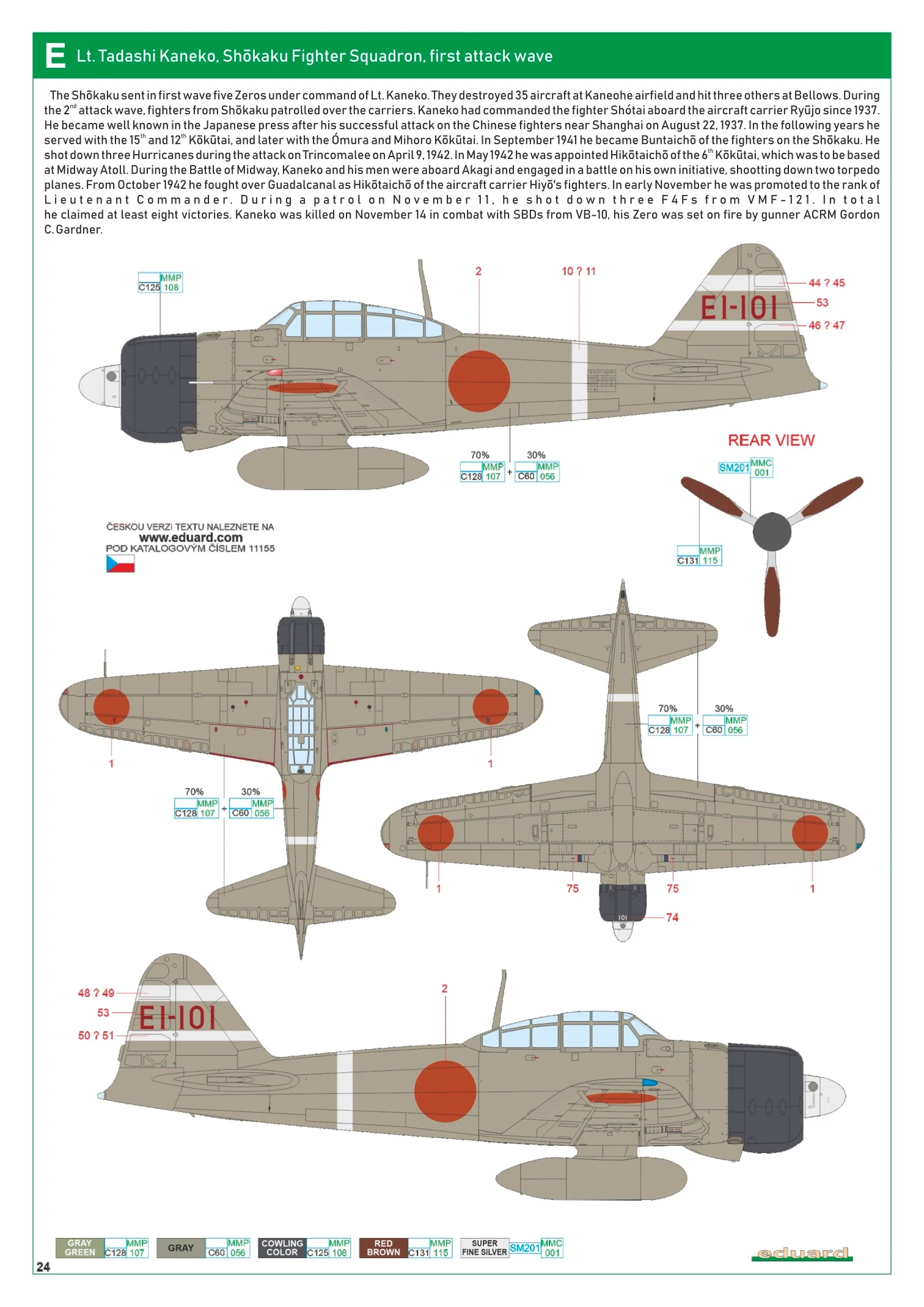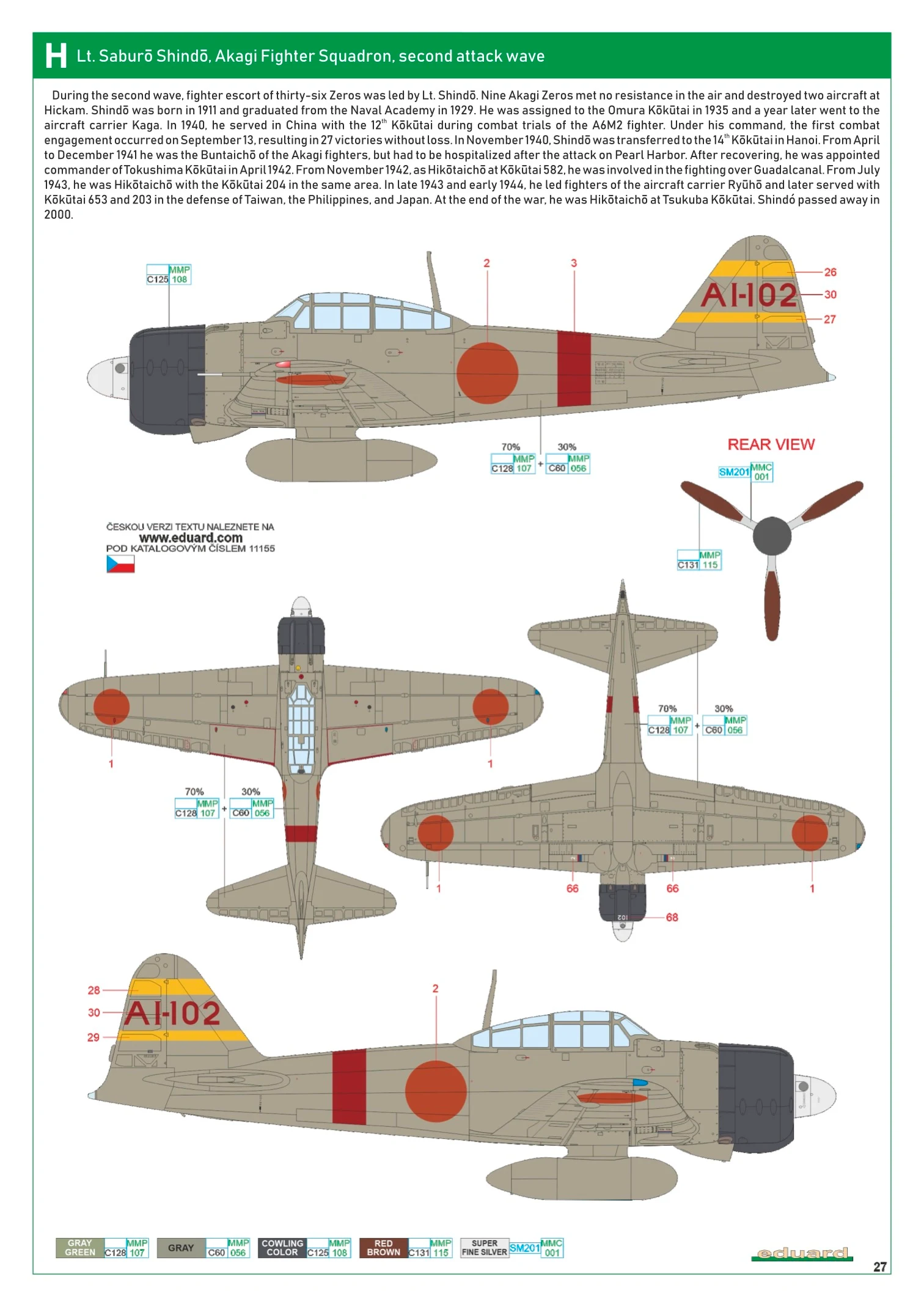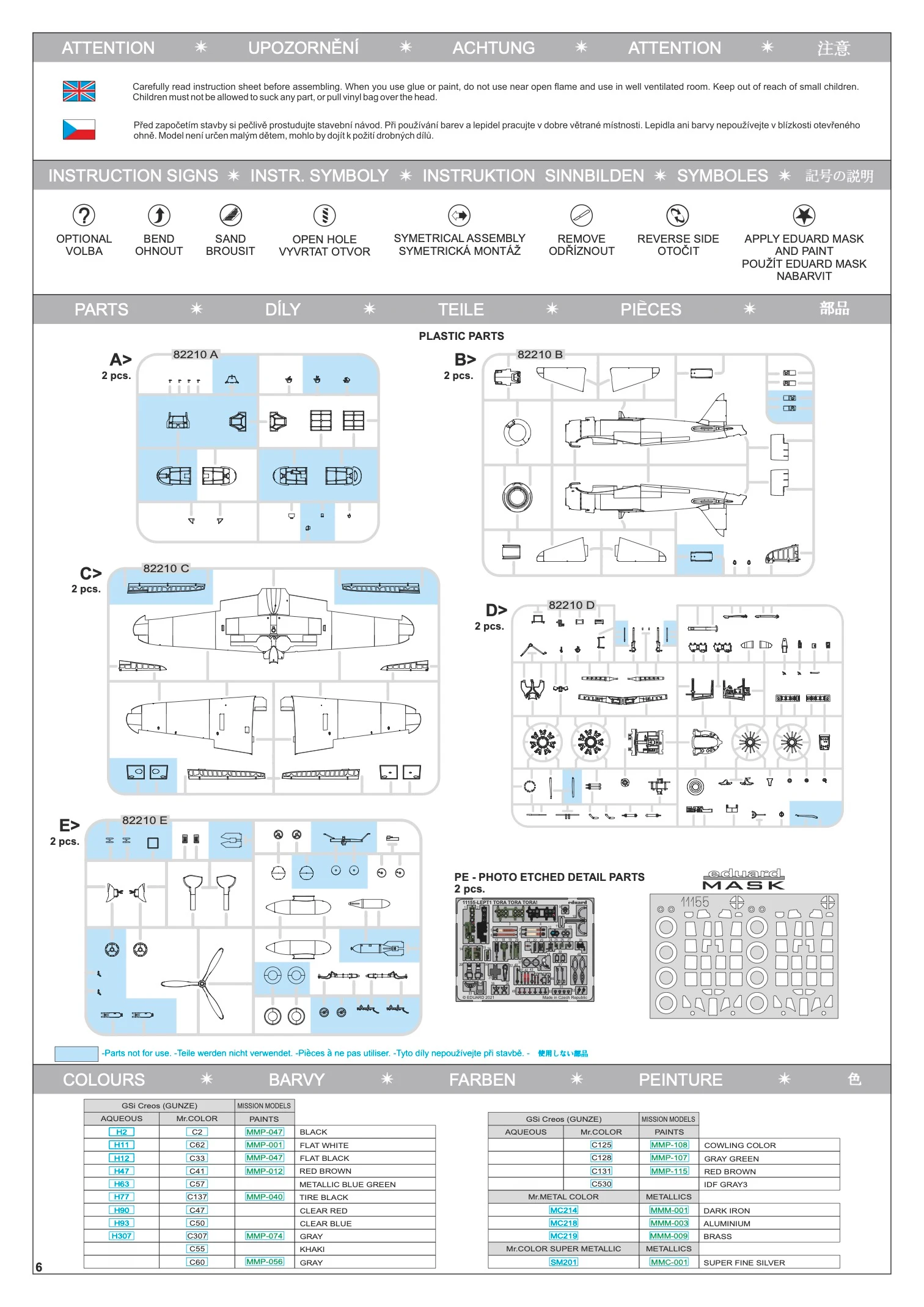Eduard's limited edition kit of Japanese 1/48th scale WWII naval fighter aircraft A6M2 Zero Type 21 & a pick of the best aftermarket for the kit is with Gary Wickham for review. His article shows you what's inside along with some great comparisons to the real thing. See what he thinks about the kit in his review...
In-boxed: TORA TORA TORA! A6M2 Zero Type 21 over Pearl Harbor
From Eduard Model Accessories
1/48th scale
Kit Includes: Photo-etched parts, painting masks, decals for 12 versions
What better choice than to start where it all began in the Pacific, with the Japanese attack on Pearl Harbour and what better aircraft to represent the might of the Japanese Imperial Navy Air Force than the iconic Zero
Of course, if you prefer an easier, stress-free drop-in option for your cockpit, then Eduard has you covered with (sold separately) both a 3D decal A6M2 SPACE (3DL48050) set and a pre-painted resin A6M2 LööK (644128) set.COLOURS & MARKINGS - Eduard 1:48 Mitsubishi A6M2 Model 21 TORA TORA TORA! Dual Combo (ED11155)
As the entire focus of this Limited Edition boxing is the A6M2 Model 21 Zero's used during the attack on Pearl Harbour, the twelve marking options included in the box are all very similar. The variations really come down to identification bands and colours used on the different carriers and squadrons for visual identification.
This is a very welcome release by Eduard. It's generally accepted that Japanese manufacturers are the leaders when it comes to Japanese subjects, especially for one as iconic as the Zero. Both Tamiya and Hasegawa already have excellent kits of the Zero (in all its variants and scales) so Eduard had some tough competition.
I'm sure that if you have even a passing interest in the Mitsubishi Zero and 1/48 is your scale that you will already have your eye on this kit. Again another winner from Eduard for modellers and history buffs alike.
Price: $98 USD from the Eduard Website
$66 USD from Hobbylink Japan
Eduard has recently released their latest all-new WWII era kit in 1/48th scale. Having already provided good subject coverage of the ETO it was finally time to give the Pacific theatre (PTO) some attention.
As they have done in previous "Limited Editions", Eduard has once again given us something special for this first boxing. Entitled “Tora, Tora, Tora”, after the Japanese code used to begin the attack on Pearl Harbor, we are treated to not one, but two (dual combo), kits of the Zero in the box.
Included in the box for this release are:
Plastic parts: Eduard (two full kits)
Marking options: 12
Decals: Eduard
Photo-Etched parts: yes, pre-painted
Painting mask: yes
Resin parts: no
Plastic parts: Eduard (two full kits)
Marking options: 12
Decals: Eduard
Photo-Etched parts: yes, pre-painted
Painting mask: yes
Resin parts: no
The retail price for the kit is US$97.95 on the Eduard Website, but it seems to be readily available for closer to the $66 USD from Hobbylink Japan. When you consider that inside you have essentially two Profipack kits and decals covering 12 aircraft, I feel that it represents pretty good value.
The subject: The A6M2 Model 21
Eduard has chosen to kick off their new Zero family with the A6M2 Model 21. The earlier A6M2 Model 11 had performed extremely well during aircraft carrier trials conducted aboard SORYU during June of 1940. But while the Zero's performance aboard the carrier was excellent, the fighters long wingspan constantly ran the risk of wingtip damage while going up and down on the carriers’ elevators.
The problem was solved by providing 20-inch wingtip panels that could be manually folded upwards. Designated A6M2 Model 21, a further production line change was introduced on aircraft No. 127 when the aileron balance was changed. The new aileron balance system was linked to the landing gear retraction system and considerably improved high-speed control by reducing the amount of force needed to move the control stick.
By the late fall of 1941, nearly 400 Rei-sen fighters had been delivered to the Imperial Navy Air Force. The carrier force was equipped with 126 Zeros and the land-based squadrons 213. The Navy's superbly trained pilots were confident that they could master any enemy met. The Japanese Imperial Navy Air Force at this time was quite possibly the strongest and most effective air force in the world. It has been pointed out that if the Luftwaffe had possessed the Zero during the Battle of Britain, history might have taken a much different course.
As strong as the Japanese Navy Air Force had become and as openly as it had been tested and used during the previous year in China — its existence would come as a near-total surprise to the United States. Japan's military leadership, however, was well aware of its strength and by the fall of 1941, this strength proved irresistible. The HAWAIIAN OPERATION (Attack on Pearl Harbor) was approved. It should be noted that the attack on the United States Pacific Fleet was not planned by the Japanese to be a ”sneak attack" but as a surprise attack after the war had been declared. However, the Japanese embassy staff was unable to decode and deliver the declaration of war prior to the actual attack.
IN THE BOX - Eduard 1:48 Mitsubishi A6M2 Model 21 TORA TORA TORA! Dual Combo (ED11155)
In keeping with recent Eduard new tooled kits, the surface detail on the new Zero is excellent. The same restrained riveting and panel lines found on their P-51 and Tempest is present and will add plenty of visual interest to the finished model, even if you don't apply a wash. As mentioned previously, the main change from the original Model 11 to the revised Model 21 was the addition of 20-inch wingtip panels that could be manually folded upwards. Eduard have opted not to provide separate wingtips in the kit plastic parts, so if you want to display your model folded you will need to do some surgery or pick up the upcoming A6M2 Zero Model 21 folding wingtips 3D PRINT set (648731)
In keeping with recent Eduard new tooled kits, the surface detail on the new Zero is excellent. The same restrained riveting and panel lines found on their P-51 and Tempest is present and will add plenty of visual interest to the finished model, even if you don't apply a wash. As mentioned previously, the main change from the original Model 11 to the revised Model 21 was the addition of 20-inch wingtip panels that could be manually folded upwards. Eduard have opted not to provide separate wingtips in the kit plastic parts, so if you want to display your model folded you will need to do some surgery or pick up the upcoming A6M2 Zero Model 21 folding wingtips 3D PRINT set (648731)
As seen on this restored A6M3, the Zero employed flush riveted skin work. The top wing skin, which was of light-gauge aluminium, did not suffer wear well.
The moulding on the lower wing is likewise surgically clean. Eduard's moulds have always been high grade but in recent times they have elevated their toolings to Tamiya level. Take a close look at the consistency of the rivets and circular fasteners across the surface of this large part. Also, note the separate cutouts provided for the lower wing cannon bays. I had assumed this was to allow Eduard to use the same parts for later variants (such as the A6M3) which had upgraded 20mm cannons and thus required a bulge in the sheet metal of the wing below each cannon. The problem with this theory is that the A6M3 wingtips were very different to the A6M2 so Eduard would need to provide whole new wings anyway. I'm sure there's a good reason.
As with the wings, the fuselage was covered with light gauge aluminium flush riveted skin work. The most common method for reproducing such surface detail by scale model manufacturers is with fine recessed holes. Whilst not entirely accurate, on a 1:48 scale model this results in a realistic appearance and gives the models surface a similar look to the real 1:1 aircraft.
The fuselage halves have been engineered by Eduard to allow the main cockpit "module" to be inserted from the bottom after fuselage assembly. The engine and its cowling are likewise a separate sub-assembly.
As can be seen the surface detail on the more complex curved fuselage parts is every bit as clean as that found on the flat wing surfaces. It's a testament to how injection moulding technology has improved in 2022.
The engine cowling has been designed by Eduard to comprise of five (5) separate parts. Cleverly, to assist in the assembly of the cowling they have included a template or jig, which is used only to align the cowling parts correctly during gluing.
The engine cowling as fitted to the Sakae 12 powered Model 11/21 A6M2 had a characteristic squared-off shape. This would change with the introduction of the later A6M3 Model which was powered by the more powerful Sakae 21 and incorporated a more rounded, bulbous cowling shape.
Eduard has chosen to mould the cowling flaps as one piece with the side panels. From the looks of it they are in the fully closed position, which is not my favourite look for any radial aircraft.
This engineering decision by Eduard also make it much harder for the modeller to decide to leave the cowling panels and nose ring off completely so that the engine could be seen.
While the Japanese navy was testing the first two Zero prototypes, they suggested that the third be fitted with the 700 kW (940 hp) Nakajima Sakae 12 engine. Mitsubishi had its own engine of this class in the form of the Kinsei, so they were somewhat reluctant to use the Sakae. Nevertheless, when the first A6M2 was completed in January 1940, the Sakae's extra power pushed the performance of the Zero well past the original specifications.
Eduard provide a nicely detailed full Sakae 12 radial engine in the kit plastic. Details such as ignition wiring are of course missing but it's quite common these days for modellers to add their own using lead or copper wire. Given how little of the engine is seen once the cowling goes on, for most modellers the kit part will be more than adequate.
If you prefer the ultimate in detail, perhaps for a diorama or vignette where the model's engine is visible, Eduard has released a separate A6M2 engine 3D PRINT (648694) engine complete with PE wiring harness.
Eduard has provided two styles of the spinner on the sprue. From my research, it appears the short spinner (E7) was factory fitted to all A6M2 Model 21's and would therefore have been appropriate for the Zero's used in the attack on Pearl Harbour. The longer spinner (E9) is the type fitted to the A6M3 and in some cases was also retrofitted to the Model 21's which were still operating later in the war. A quick look at the instructions for the second boxing of this kit (82212) confirms this as Eduard calls for the use of the larger spinner in 3 or the 5 marking options provided.
The shape of the tail of the A6M remained largely unchanged during the war as new variants were introduced. In common with its contemporaries at the start of the war, the Zero employed fabric-covered control surfaces for ailerons, elevators and rudder.
Eduard has a good track record when it comes to accurately reproducing fabric-covered surfaces. The use of lightweight fabric helped keep the overall weight of the Zero down and resulted in it being known as one of the most nimble fighters of WW2.
The Zero cockpit, whilst not spacious, was functional and well organised. To keep the weight down little or no armour plating was added to the cockpit areas in order to protect the pilot. This approach was very different to allied aircraft design which put a large focus on crew protection.
As we have come to expect, all the cockpit components are cleanly moulded and designed to get the most of the plastic parts. Of course, Eduard has announced super detailed resin and 3D printed options coming separately. The inevitable "Weekend" edition of the A6M2 kit will rely entirely on the plastic parts with no PE or resin inclusion.
Being a "Limited Edition" release, Eduard includes the Profipack style coloured photoetch fret. As this is a Dual Combo kit, two PE frets are included. A quick scan of the assembly instructions shows that 95% of the PE is destined for the cockpit area.
The early Zero drop tank, as fitted to the A6M2, was all-metal construction. Later in the war (presumably as metal became scarce), the drop tanks from the A6M5 onwards were made from wood. Eduard has accurately reproduced the combination of raised and flush rivets as well as the raised weld seams commonly found on drop tanks.
The single clear sprue (A) holds all the various canopy options provided in the kit. Parts A12 and A14 allow the sliding canopy to be displayed open or closed. Four versions of the large rear fixed canopy section are included. Small changes to the framing on these area's naturally occurred as the Zero evolved and Eduard has taken this into account. Three different variants of the gunsight used in the Zero are included and finally two options for the windshield (one with late-model 45mm armoured glass plate).
Drawing from the combat reports of pilots of the A5M Claude over China regarding poor pilot visibility, Mitsubishi made efforts to dramatically improve the canopy design on the new A6M aircraft. The resulting new "greenhouse" canopy afforded the Zero pilots with excellent visibility and increased situational awareness which would often make all the difference in a tight turning dogfight.
It's often said the "devil is in the details" and when it comes to research and translating that detail into plastic there are very few who can match Eduard. By way of a simple example, Eduard has made the effort to include parts that reflect the subtle differences found in early and late rear canopy types.
Eduard's own aftermarket for this release:
Along the way in this review, I have shown a handful of the aftermarket parts that Eduard have produced to go with their new Zero kit. As you would expect there are plenty more available and yet more coming, especially as Eduard is now embracing 3D printing technology more widely. How many of these options you use is a matter of personal taste and it occurred to me that because Eduard does such a good job on the kit plastic parts that often the replacement parts offer only marginal improvements.No matter how good your plastic tooling is, you can always do a little better. Eduard has already released a 3D printed alternate seat (648698) which after clean up is designed to be a direct drop-in replacement for the plastic part.
From the cockpit to the undercarriage, again sold separately are Eduards A6M2 Zero Brassin wheels make a "must-have" accessory for your Zero. If the detailed radial tread does not convince you, then raised sidewall lettering (in Kanji no less) should.
Also available as an upgrade option is the A6M undercarriage legs BRONZE (648695) set. Designed to replace the kit plastic main gear doors and main struts, these resin and cast bronze pieces provide sharper detail and considerably more strength.
As the entire focus of this Limited Edition boxing is the A6M2 Model 21 Zero's used during the attack on Pearl Harbour, the twelve marking options included in the box are all very similar. The variations really come down to identification bands and colours used on the different carriers and squadrons for visual identification.
Images throughout are from the "A6M Zero in Action - Aircraft No. 59"
Perhaps the hottest topic I have seen discussed/debated on the internet about this kit is the best choice for the "amber grey" used on the IJN Zeroes. As you would expect, Eduard did a LOT of research themselves on this topic and if this interests you, even a little, I would strongly recommend you have a read of the article "The Colors of Zero" by Marian Holly on page 48 of the Jan 2022 Eduard INFO magazine.12(!) marking choices in the kit:
Markings are provided from each carrier attack group for both the first and second waves. I particularly appreciate the inclusion of a brief, but detailed, history of the aircraft, the pilot and how both specifically participated in the attack on Dec 7, 1941.The Decals:
The decals in this kit are once again printed by Eduard themselves (and not Cartograph). Much has been said (good and bad) about the "new" Eduard printed decals which have a removable carrier film. Of the many built examples of this model I have seen on the web, all of them seem to use the kit decals and reported no issues.The stencils of this kit...
The stencil map in the instructions
CONCLUSION - Eduard 1:48 Mitsubishi A6M2 Model 21 TORA TORA TORA! Dual Combo (ED11155)This is a very welcome release by Eduard. It's generally accepted that Japanese manufacturers are the leaders when it comes to Japanese subjects, especially for one as iconic as the Zero. Both Tamiya and Hasegawa already have excellent kits of the Zero (in all its variants and scales) so Eduard had some tough competition.
I also like that Eduard launched its new Zero tooling with a special edition which included two models in one box. The choice of a Pearl Harbour theme is also clever because it's not just about the A6M2 Model 21, but also the history of what happened on that day "which will live in infamy".
Gary Wickham
Check out the Eduard Website for more information on all of their releases...
You can see more of Gary's model making on his website Scalespot.com
ASSEMBLY INSTRUCTIONS - Eduard 1:48 Mitsubishi A6M2 Model 21 TORA TORA TORA! Dual Combo (ED11155)










































































